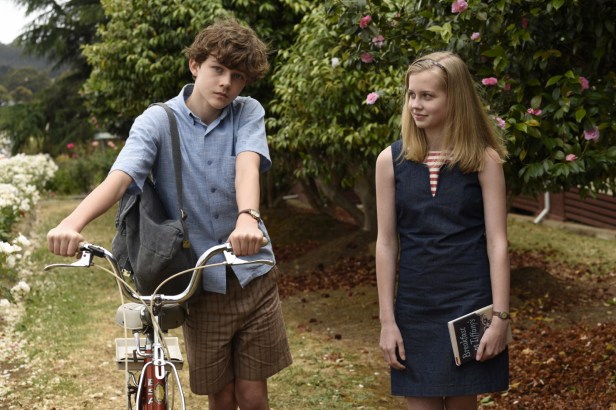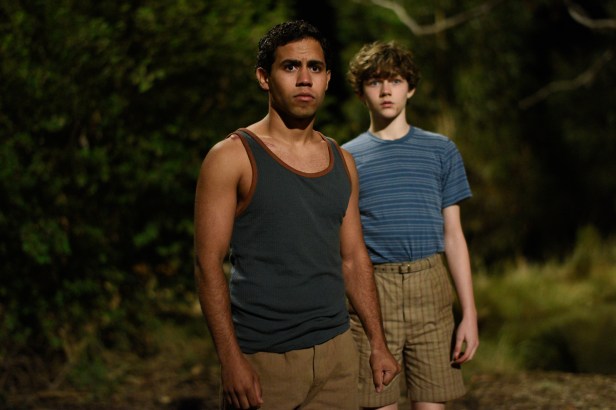Jasper Jones (2017)
A knock at the window. Their lives changed forever.
In recent years Australian cinema has become a hot bed for book-to-film adaptations. We take a much-loved, world-renowned novella and cram it into a 90-plus minute fiesta of themes and visuals. Jasper Jones, the latest to make the book-to-movie jump, is no exception. Directed by Rachel Perkins, Bran Nue Dae (2009), the film — based on Craig Silvey’s much-loved 2009 paperback — is a cornucopia of superbly acted, beautifully shot, yet tonally jumbled scenes, the narrative, more often than not, straying too far from its chief premise.
The story is that of Charlie Bucktin (Levi Miller), a lanky 14-year-old boy living in the 1960s, who resides in the fictitious rural town of Corrigan, Western Australia. Set during the scorching summer of ’69 — post-Christmas December to be precise — our shy, bookish protagonist, Charlie, is, late one night, visited by social outcast Jasper Jones (Aaron L. McGrath), a mixed-race (White-Aboriginal) adolescent with a sketchy past and a horrifying secret. After a brief discussion, Charlie is coerced into following the anxious Jasper into the dense thicket, where he is shown something truly disturbing: the dead body of Laura Wishart. Believing that Jones is not the culprit, Charlie agrees to aid Jasper in finding the perpetrator and prove Jones’ innocence; Jasper convinced that the man responsible was the infamous Mad Jack Lionel (an almost unrecognizable Hugo Weaving), the pair setting off to validate their somewhat ‘flimsy’ theory.

Written by Shaun Grant, The Snowtown Murders (2011), and author Craig Silvey (who also penned the novel), the screenplay features so many twists and turns that it becomes a little difficult to pinpoint the actual plot. When breaking it down, Jasper Jones — the story’s source material often described as being Australia’s very own To Kill a Mockingbird — can be summed up as a coming-of-age story, moviegoers following Charlie on his quest to discover the truth, our hero forced to find himself and grow up rather quickly. See, this 14-year-old boy is suddenly confronted with death, suicide, racism, wartime conflict, police brutality, domestic violence and the threat of his own family’s collapse (this in the form of his parents’ divorce). While this is certainly a lot for a teenage boy to handle, the flood of material can also be a too much for the audience to digest, too.
This is somewhat disappointing if you ask me, considering that the atmosphere is so well set within the first few frames, Perkins drawing viewers into the mystery of what appears to be a murder — a young girl found hanging from a tree, bruised and beaten, while a heartbroken, angry delinquent (catalyst Jasper Jones) pleads for Charlie’s help in finding out who killed her. We are given a suspect, the reclusive Mad Jack Lionel, and set on a path. However, the very next morning, when Charlie wakes, Laura’s death still fresh in his mind, he’s happy to go along to cricket practice with his best friend Jeffrey Lu (Kevin Long), son of the only Vietnamese family living in the remote countryside town, the Lu’s burdened with constant race-hate due to the ongoing Vietnam War. While this shift certainly reinforces the idea that Charlie is still only a kid, the tone and overall mood becomes muddled, Charlie content to just drift along, tailing secondary characters until the mystery is almost solved on its own. And when we are finally introduced to the Wishart family, through Charlie’s schoolmate Eliza (Angourie Rice), it feels a little too late; there doesn’t seem to be any real sense of urgency in cracking the case or discovering the reasons behind Laura’s (Eliza’s older sister) untimely passing.

Perhaps this is because Charlie has a lot on his plate. For one, he is baffled about the prejudice surrounding his best friend’s family. He’s also concerned about Jasper, who has become a fugitive from the law. All the while, Charlie’s mother, Ruth (portrayed by the enormously talented Toni Collette), worries about her son growing up too quickly and makes numerous attempts to connect with him. Charlie, though, has adolescent growing pains of his own, Eliza — the girl he has confused romantic feelings towards — being angry with him, too. And, to top it all off, there’s a violent murderer walking free on the streets of Corrigan. Poor kid!
Thankfully the characters are incredibly rich and full of personality, each meticulously crafted by both writer and actor; the performances (for the most part) just a demonstration of the impeccable talent Australia has to offer. That said, not all the chief players are given ample screen time, this limiting the depth in which each can be explored. As previously mentioned, Toni Collette, Muriel’s Wedding (1994), does a fabulous job as Charlie’s mother Ruth (who’s given far too few scenes), Collette painting a picture of a surprisingly complex woman full of desire, ambition and love. Where a lesser actress could have made the character come across as angry, desperate, irresponsible and even pathetic, Collette manages to squeeze three-dimensional candor into what might have otherwise been a two-dimensional role. Relative newcomer Aaron L. McGrath, Around the Block (2013), portrays the titular Jasper Jones, a juicy prime rib of a character with only a handful of scenes, McGrath making the most out of Jones’ intricate arc, given his small amount of time on screen. McGrath shares the better part of Jasper’s personal journey with the incredibly gruff looking Hugo Weaving, The Dressmaker (2015), who, while it’s a crime to have him play such a small roll, honestly makes the journey worthwhile.

Charlie is brought to life by the 14-year-old Levi Miller, the Australian-born actor best known for playing Peter Pan in 2015’s Pan, Miller tasked with a tough, multifaceted role that’s no doubt difficult to wholly portray, especially seeing as his character is given little to no respite from the trauma he’s experiencing. The times Charlie seemingly forgets about Laura’s decomposing body (which he and Jones hastily dump into a nearby pond), such as watching Jeffrey play a pretty inspiring game of cricket, no joke, at least stand as lil’ highlights within themselves; this unevenness is definitely an oversight by director Perkins, which is a shame, as there are so many elements that she does get oh-so-right. Fortunately, the support cast are equally as endearing, with fetching up-and-comer Angourie Rice — who recently starred alongside Russell Crowe and Ryan Gosling in 2016’s The Nice Guys — rendering Eliza, the doe-eyed daughter of the local town President (who’s just lost his eldest daughter), with girl-next-door charisma and a gleaming sense of allure, while newcomer Kevin Long is enthusiastic to a tee as Charlie’s Vietnamese, cricket-lovin’ pal, Jeffrey, Long and Miller often engaged in laugh-out-loud nerd-like banter.
Visually, the film makes some interesting choices, with some exciting cinematography by Mark Wareham, Felony (2013); however, the use of vibrant patterns and bright colors seem only to serve as a backdrop for the narrative and the era in which the storyline takes place. This pallet only reinforces the confusion one faces when looking at the overall tone of the film. The main character is a teenager confronted with a very adult problem, yet, in the past, movies of such ilk have often been geared more towards a younger demographic. But for some reason, the powers that be (aka, the producers) have decided to pitch Jasper Jones as a far more adult affair — unless, all of a sudden, strangled corpses and repeatedly screaming ‘f**k’ earns you a PG-rating. Strange, considering that the film is far lighter than the book on which it is based.

A lot of my frustration around Jasper Jones, as a motion picture, stems from the fact that it was so close to being perfect. The performances are noteworthy and engrossing, but not given enough weight, the story, intriguing but becoming tangential and a tad too zig-zaggy, and the look, refreshing but occasionally displacing and over-saturated. Despite an ending rooted in ambiguity (a scene which features the burning of a house that’s literally open to multiple interpretations), Jasper Jones is an inspired, eye-opening affair, the film shining a light on 1960s Australia, a time of countrywide political and social upheaval. Look, it’s great to see an Australian movie come so close to being what everyday Aussies want from homegrown cinema. But hey, it’s a step in the right direction!
3 / 5 – Good
Reviewed by Kathryn Snowball
Jasper Jones is released through Madman Entertainment Australia